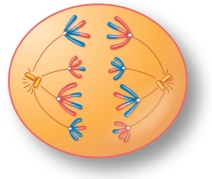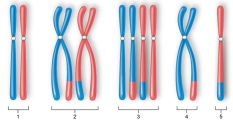A) prophase I, 2n=4
B) prophase II, 2n=4
C) metaphase I, 2n=4
D) metaphase II, 2n=2
E) anaphase II, 2n=2
G) A) and E)
Correct Answer

verified
Correct Answer
verified
Multiple Choice
Chromosomes that occur in pairs and code for the same traits are called _____________ chromosomes; these do not include the __________________ chromosomes which code for gender.
A) homologous; autosomes
B) autosomes; homologous
C) diploid; haploid
D) homologous: sex
E) sex; autosomes
G) A) and C)
Correct Answer

verified
Correct Answer
verified
Multiple Choice
Which of the following phases results in separation of sister chromatids into daughter chromosomes?
A) anaphase of mitosis
B) anaphase I, anaphase II, and anaphase of mitosis
C) anaphase I and anaphase II
D) anaphase I and anaphase of mitosis
E) anaphase II and anaphase of mitosis
G) C) and D)
Correct Answer

verified
E
Correct Answer
verified
Multiple Choice
For the figure shown here,indicate the correct stage of meiosis and diploid chromosome number. 
A) anaphase I, 2n=16
B) anaphase II, 2n=16
C) anaphase I, 2n=8
D) anaphase II, 2n=8
E) anaphase II, 2n=4
G) A) and D)
Correct Answer

verified
Correct Answer
verified
Multiple Choice
Which of the following is not a symptom of Down syndrome?
A) increased mental abilities
B) eyelid fold
C) stubby fingers
D) short stature
E) fissured tongue
G) A) and E)
Correct Answer

verified
Correct Answer
verified
Multiple Choice
Camels have a diploid chromosome number of 70.At prophase II,each cell would contain how many chromatids?
A) 0
B) 35
C) 70
D) 140
E) 280
G) None of the above
Correct Answer

verified
Correct Answer
verified
Multiple Choice
During G1 stage of interphase,a diploid organism contains how many copies of each gene?
A) 1
B) 2
C) 4
D) 8
E) 16
G) B) and C)
Correct Answer

verified
Correct Answer
verified
Multiple Choice
Swyer syndrome (46,XY,female appearance) ,would most likely result from
A) nondisjunction during meiosis I in the female parent.
B) nondisjunction during meiosis I in the male parent.
C) nondisjunction during meiosis II in the female parent.
D) nondisjunction during meiosis II in the male parent.
E) normal disjunction during meiosis, but deletion of portion of the Y chromosome in the male parent.
G) All of the above
Correct Answer

verified
Correct Answer
verified
Multiple Choice
The failure of sister chromatids to separate during meiosis is called
A) synapsis.
B) crossing-over.
C) tetrad formation.
D) disjunction.
E) nondisjunction.
G) B) and E)
Correct Answer

verified
Correct Answer
verified
Multiple Choice
Goats have a diploid chromosome number of 60.At prophase I,each cell would have ____ tetrads present,for a total of _____ chromatids.
A) 30; 120
B) 30; 60
C) 60; 120
D) 60; 240
E) 30; 240
G) B) and D)
Correct Answer

verified
Correct Answer
verified
Multiple Choice
Which of the following statements is true?
A) Chromosomes are classified into two categories, the sex chromosomes that determine gender and autosomes that determine non-gender related traits.
B) Homologous chromosomes differ in banding patterns, the traits they code for and size.
C) While sex chromosomes determine different genders they look the same until they are stained.
D) In humans all 46 chromosomes have an identical match called the homologue.
E) Chromosomes are classified into two categories, autosomes that determine gender and the sex chromosomes that determine non-gender related traits.
G) D) and E)
Correct Answer

verified
Correct Answer
verified
Multiple Choice
In each gamete following telophase II,how many copies of each gene is/are present?
A) 1
B) 2
C) 3
D) 4
E) 8
G) A) and B)
Correct Answer

verified
A
Correct Answer
verified
Multiple Choice
An egg with 22 chromosomes that is fertilized by a normal sperm will result in
A) a zygote with trisomy.
B) a zygote with disomy.
C) a zygote with monosomy.
D) a zygote with normal chromosome number.
E) nondisjunction during subsequent mitosis.
G) A) and C)
Correct Answer

verified
Correct Answer
verified
Multiple Choice
Which of the following processes and products are paired correctly?
A) spermatogenesis - 2n zygote
B) oogenesis - 2n zygote
C) oogenesis - 1n gamete
D) meiosis - 2n zygote
E) mitosis - 1n gamete
G) B) and C)
Correct Answer

verified
Correct Answer
verified
Multiple Choice
An individual with the karyotype 48,XYYY would have how many Barr bodies?
A) 0
B) 1
C) 2
D) 3
E) 4
G) B) and C)
Correct Answer

verified
Correct Answer
verified
Multiple Choice
Interphase differs from interkinesis because
A) DNA is duplicated during interphase, but not during interkinesis.
B) DNA is duplicated during interkinesis, but not during interphase.
C) homologous chromosomes separate during interkinesis, but not during interphase.
D) homologous chromosomes separate during interphase, but not during interkinesis.
E) interkinesis only occurs during mitosis, while interphase occurs during both meiosis and mitosis.
G) A) and B)
Correct Answer

verified
A
Correct Answer
verified
Multiple Choice
Camels have a diploid chromosome number of 70.At prophase II,each cell would contain how many tetrads?
A) 0
B) 35
C) 70
D) 140
E) 280
G) A) and B)
Correct Answer

verified
Correct Answer
verified
Multiple Choice
All but which one of these results from nondisjunction?
A) trisomy
B) diploidy
C) monosomy
D) polyploidy
E) Down syndrome
G) None of the above
Correct Answer

verified
Correct Answer
verified
Multiple Choice
Which of the following human syndromes is a monosomy?
A) Turner syndrome
B) Klinefelter syndrome
C) Down syndrome
D) Swyer syndrome
E) Barr body syndrome
G) B) and C)
Correct Answer

verified
Correct Answer
verified
Multiple Choice
Figure:  -Which of the diagrams represents a chromosome pair in a cell at the end of prophase II?
-Which of the diagrams represents a chromosome pair in a cell at the end of prophase II?
A) diagram 1
B) diagram 2
C) diagram 3
D) diagram 4
E) diagram 5
G) A) and D)
Correct Answer

verified
Correct Answer
verified
Showing 1 - 20 of 55
Related Exams